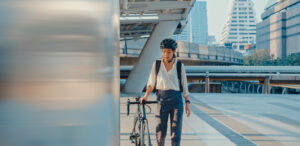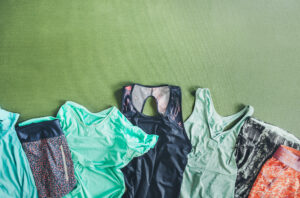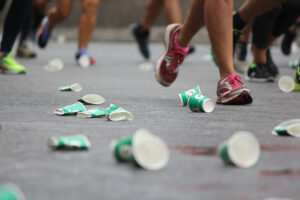Sustainability in Running: What We in the Running Community Can Do to Be More Environmentally Friendly During Races and Training
When you go out on a run, sustainability probably isn’t the number one thing you think about. The only time it might come to your mind is when you see litter along your route and make sure that your gel wrapper is safely tucked in your pocket, waiting to be disposed of at home. If you’re one of us occasionally completing our (cross-) training in the form of work commute, you might be slightly more aware of the good you’re doing for our planet. However, come race day, sustainability probably isn’t the number one topic you’re thinking about. On this Earth Day, let’s focus on the good you can do during your training as well as the San Francisco Marathon’s efforts to make our events as eco-friendly as possible.

Edited by Pavlína Marek
If the idea of protecting the environment didn’t cross your mind at all, don’t worry! It’s not many people’s first concern when taking on a marathon. However, it’s crucial to consider how you might be able to lessen your impact on the environment on a day-to-day basis, including your training. There are a few big things you can do that have a positive impact and a TON of smaller ones that add up all the same!
What Can You Do While You’re Training?
Being a sustainable runner starts with what you do as you’re training at home. Before we even start running we can look at how we prepare for our runs at home. While that usually means things like stretching and warming up, this time, let’s focus on your running gear and how you take care of it.
It Begins Before You Leave Home…
Using a microfiber catcher like the ones mentioned in the study is a good way to reduce how many enter the wastewater system. An even better way to be more sustainable is to wash your running gear less often. Many of you may balk at that suggestion. However, you may be surprised how little difference wearing your clothes two or three times between washes makes, so long as you hang them in a way that they can dry between workouts.

What Can You Do When Out There?
You can continue to practice your sustainability once you have made it out of the house to start your runs, too. Along with adopting as many reusable items (such as water bottles) as you can, you should hold on to any trash from all single-use items or snacks you bring with you. When you keep your trash in a pocket or pouch you’re doing your part to ensure more litter isn’t spread when you’re out there, training.
If you want to go the extra mile (ha), you can participate in what’s known as plogging. A term coined and spread by the Swedish, plogging combines the act of picking up litter while you’re out on your run. In addition to being good for the environment, it also helps diversify your workout by using different motions and muscle groups as you grab each piece of trash off the ground. By incorporating one, some, or all of these practices into your training routine you can vastly increase the sustainability of your running.
(An Aussie runner named Beau Miles gamified his marathon run by incorporating, among other things, tree planting, repairs of broken things, and plogging! He also did a literal Rubbish Run and spent 24 hours planting trees in an ultramarathon fashion.)
Commutes and (Cross-) Training
While not everyone is fortunate to live close enough to their workplace to be able to commute by bike or running, for the rest, it’s a great way to spice up the way to work. For some (like our editor), it’s sometimes also the only way; in the middle of winter when the roads are impassable, a pair of cross-country skis make for a great commuting vehicle and the perfect cross-training session.
Snow isn’t a problem for Bay Area commuters. However, if you’re tired of sitting in traffic jams for hours every single day, replacing the car for a bike and your legs might also be a good option. Many BART stations have lockable bike boxes so you can ride to your local BART station, take the train into the city, and walk the rest of the way.
Got a little more time? Here are two oddball ways Beau Miles commuted to work!
What Does Sustainability Look Like on Race Day?
Sustainable practices don’t have to halt coma race day—if anything, they’re even more important during the race! With thousands of people racing and thousands more supporting the event, the potential for waste is high. Luckily, there are even more ways to be sustainable on race day than there are during your training days.

As a runner, the best thing you can do is to keep using all the sustainability practices you’ve been using while training for the race. And while no one expects you to start plogging during the marathon, holding onto your trash until you can dispose of it properly can make a big difference. This includes a few simple tasks.
- Throw any cups you take from water stations along the route into trash bins.
- Carefully store any gel packs, wrappers, bandages, and other litter until you find a trash can. That way, they don’t end up scattered along the roads, park paths, or in the water below.
What Does the San Francisco Marathon Do?
It’s not all on you to make that difference! SFM does its part as well. What are some ways the San Francisco Marathon helps alleviate its impact on our environment?
Final Words
Creating a more sustainable race and running community is a big goal for the San Francisco Marathon. Many distance runners prefer to run outdoors, either in nature or through their neighborhoods. We can maintain or even improve the quality of your running routes by taking care of the space around us. This is doubly true when we all come together on race day in San Francisco. We all need to work together to make sure the earth and all the different races, events, and running paths on it are there for people to enjoy to the fullest in the future.


